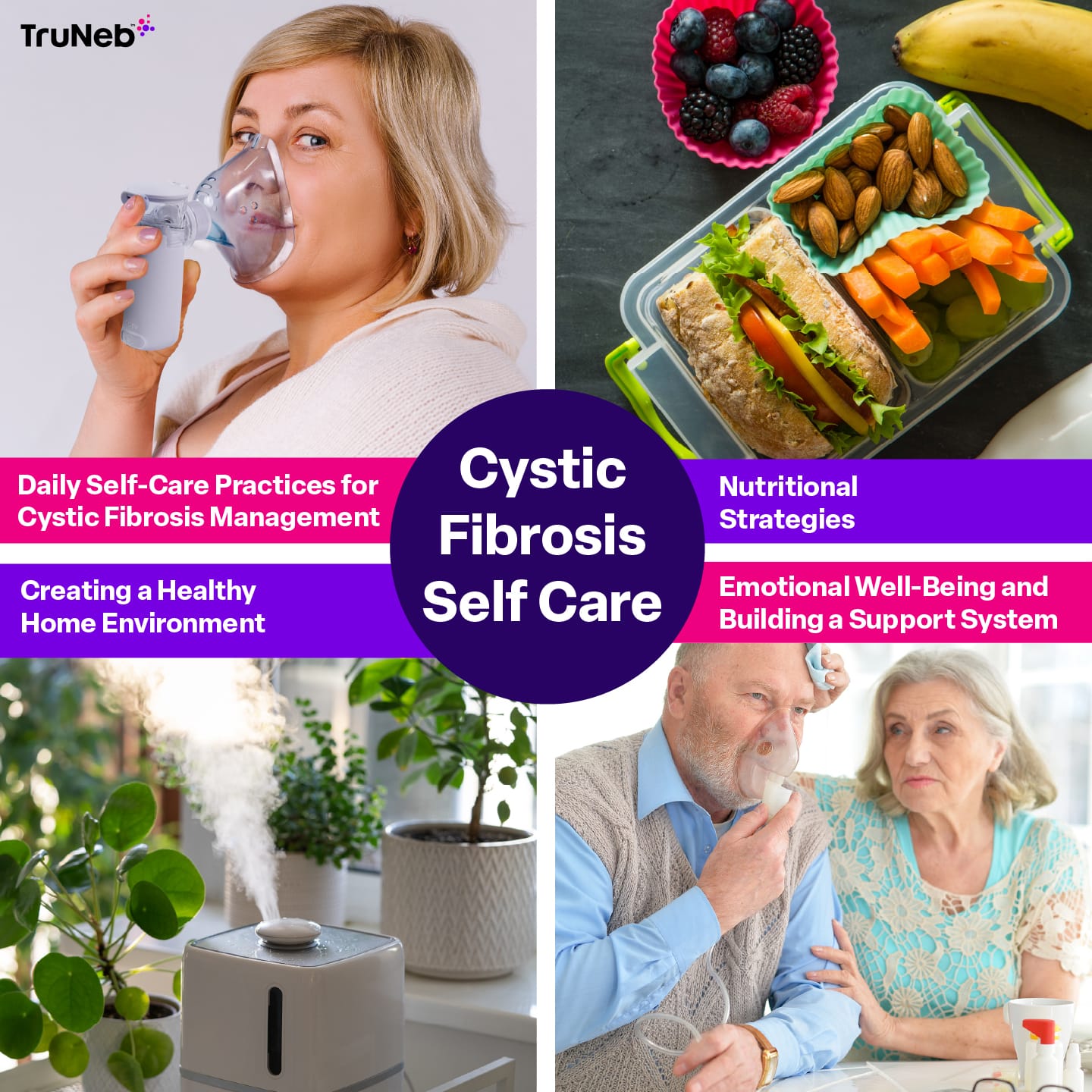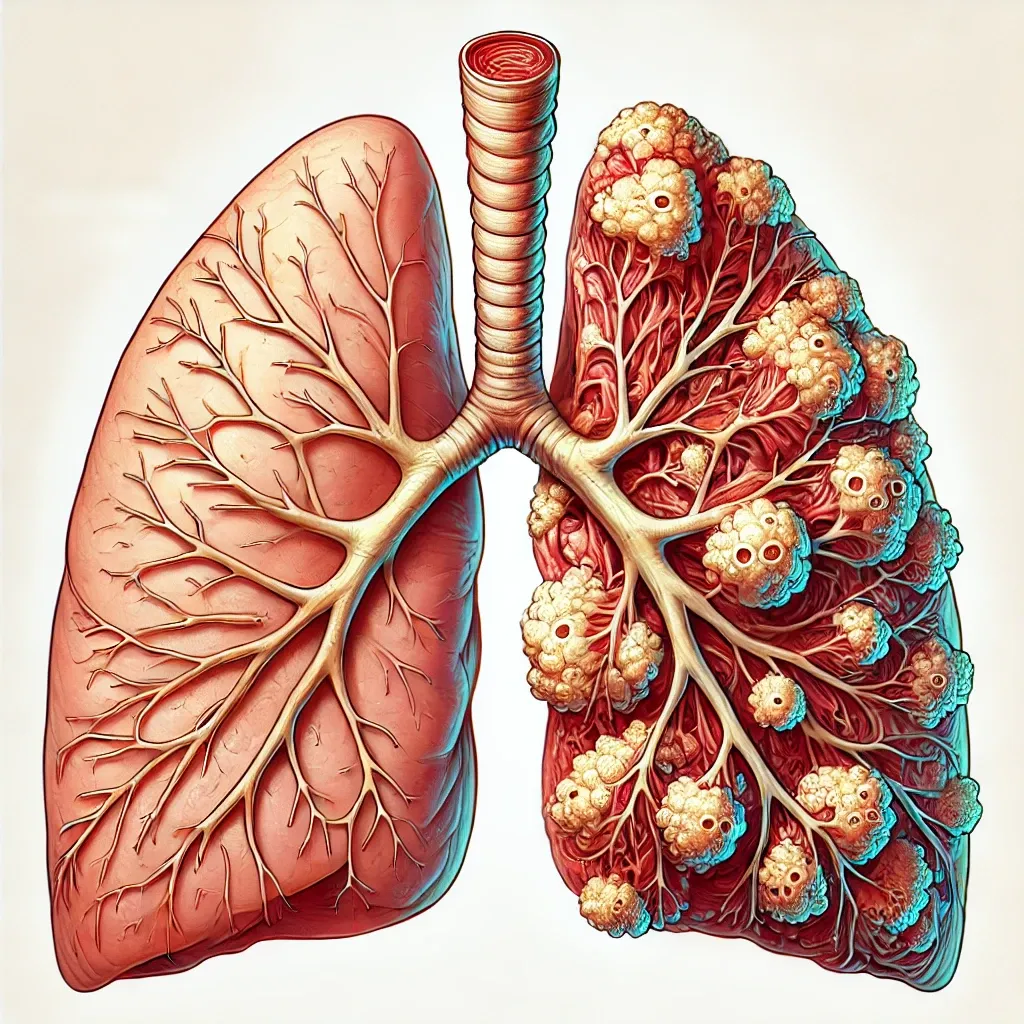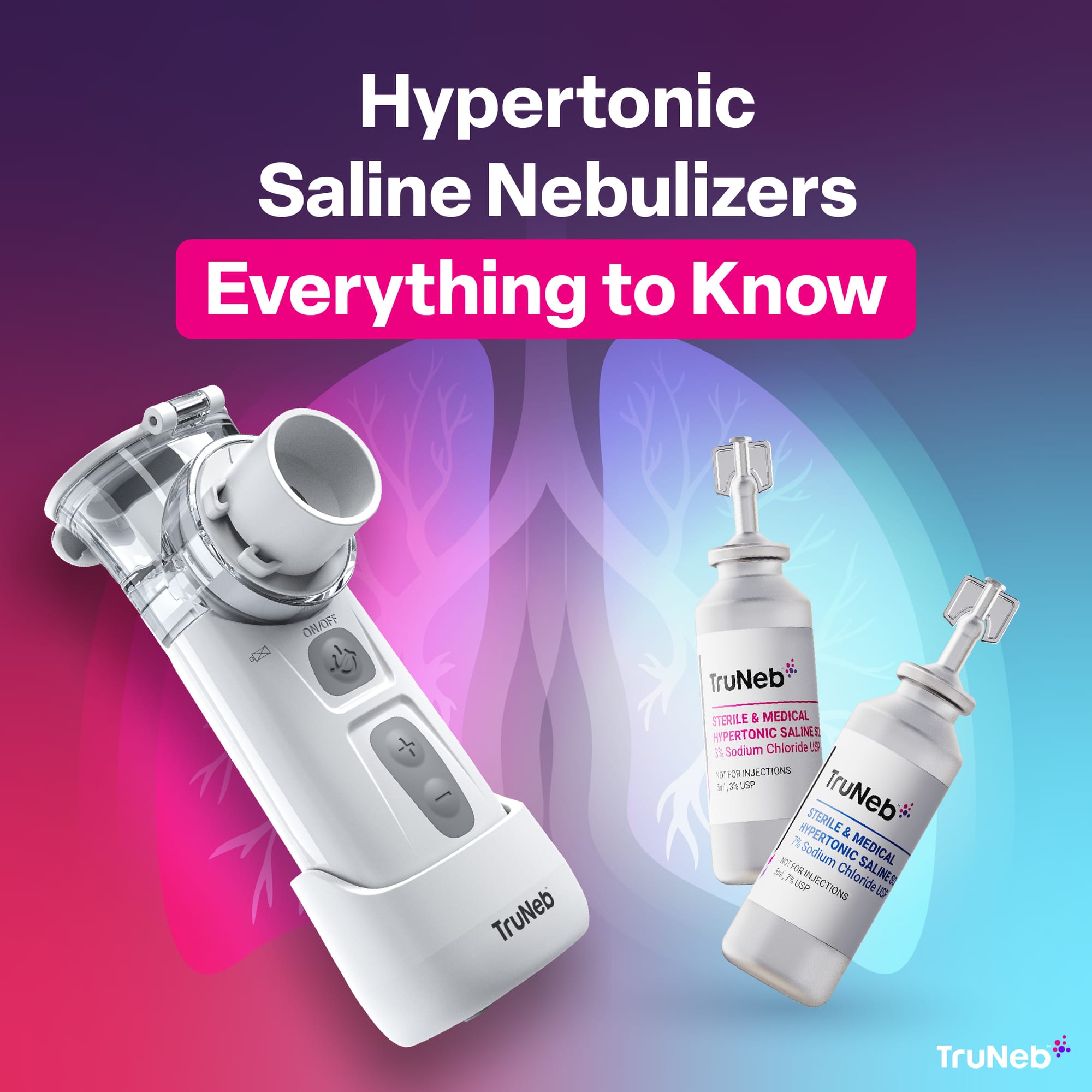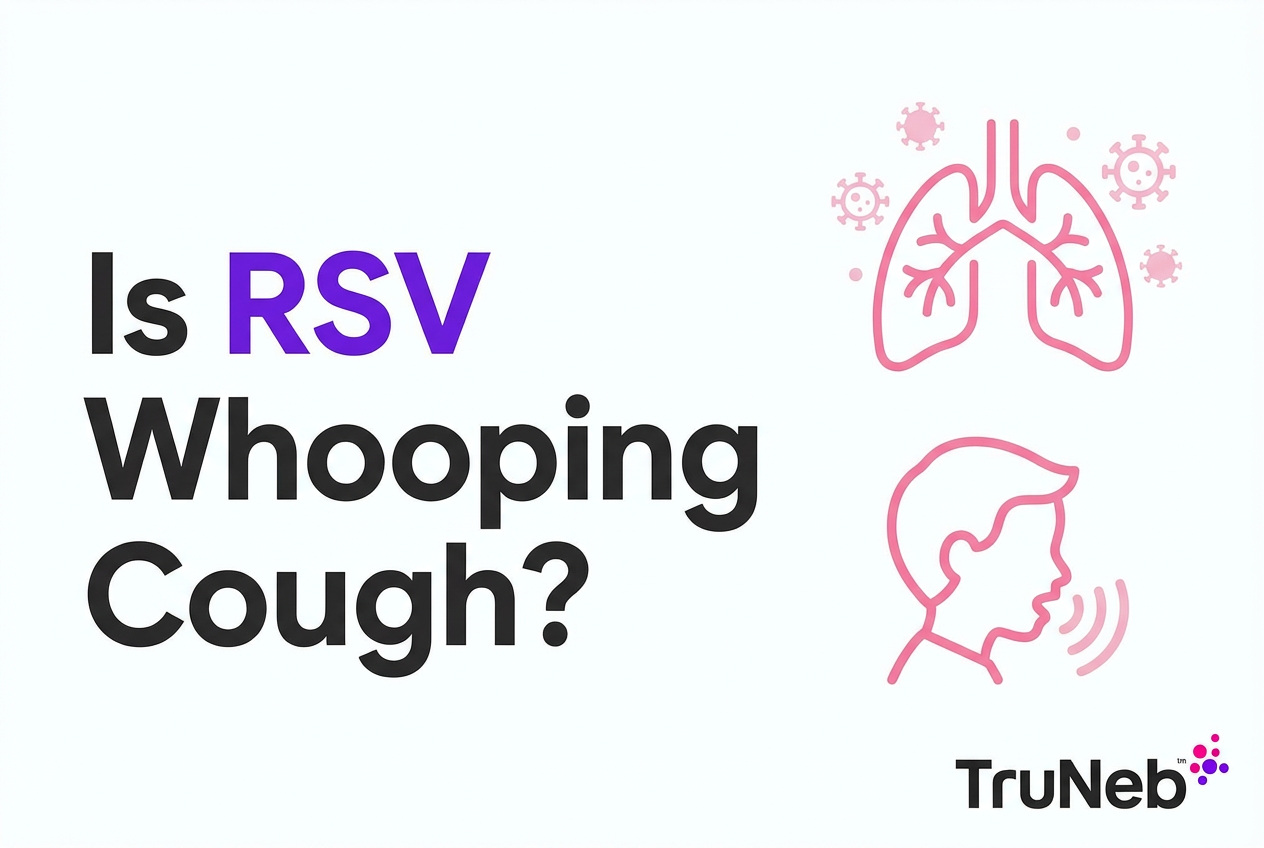On this page

Living with cystic fibrosis (CF) can be demanding, but self-care plays a major role in making life with CF more manageable. Cystic fibrosis is a genetic condition that affects the lungs and digestive system by producing thick, sticky mucus, leading to respiratory and digestive challenges. Daily self-care is more than just following your treatment plan. It’s about taking control of your health and well-being for the long run.

Taking time each day for cystic fibrosis self-care, whether it’s clearing your airways, eating the right foods, or staying active, helps you keep symptoms in check and prevents complications. These daily practices are your best defense against the progressive nature of CF. Over time, the small, consistent steps you take can lead to better health outcomes, like fewer lung infections and improved lung function. It’s not just about getting through each day—it’s about giving yourself the best chance to live well despite the challenges CF brings.
Consistency Matters in Cystic Fibrosis
When managing your disease, consistency is everything. Because CF symptoms can be unpredictable, having a routine helps you stay in control. Regularly practicing your self-care routines, like airway clearance and exercise, keeps your condition stable and can reduce the chances of complications down the road.
It’s the little things you do every day that make the biggest difference. Sticking to your airway clearance techniques helps keep your lungs clear, reducing the risk of infections. Eating a balanced, high-calorie diet ensures your body gets the nutrients it needs to stay strong. By making these habits a regular part of your day, you’re empowering yourself to live life to the fullest!
Daily Self-Care Practices for Cystic Fibrosis Management
Airway Clearance Techniques (ACTs)
One of the most important aspects of cystic fibrosis self-care is keeping your airways clear of mucus. This helps prevent infections and keeps your lungs working as well as possible. There are several techniques that can make this process more effective, each with its own benefits. Let’s look at some of the key airway clearance techniques you can incorporate into your daily routine.
PEP Therapy (Positive Expiratory Pressure)
Benefits of PEP Therapy:
PEP therapy is a simple yet powerful way to keep your airways open and help move mucus out of your lungs. By breathing out against resistance, PEP therapy helps to push mucus into larger airways where it can be cleared more easily. This technique not only helps with mucus clearance but also improves your overall lung function and reduces the likelihood of infections.
How to Perform PEP Therapy:
- Prepare Your Equipment: You’ll need a PEP device, which your healthcare provider will help you choose and teach you how to use.
- Get Comfortable: Sit in a chair with your back straight. Relax your shoulders and take a few normal breaths.
- Seal the Mouthpiece: Place the mouthpiece of the PEP device in your mouth, making sure your lips form a tight seal around it.
- Inhale Deeply: Take a deep breath in through your nose, filling your lungs as much as possible.
- Exhale Against Resistance: Breathe out slowly and steadily through the PEP device. You should feel a slight resistance as you exhale. This resistance helps keep your airways open and moves mucus up.
- Repeat the Process: Continue the cycle of deep breaths and slow exhalations for about 10-20 minutes, or as directed by your healthcare provider.
- Clear the Mucus: After completing the PEP therapy, huff cough or perform other airway clearance techniques to help expel the loosened mucus.
Huff Coughing
Steps to Effectively Perform Huff Coughing:
Huff coughing is a gentle and controlled way to clear mucus from your lungs without causing strain. It’s especially useful after using techniques like PEP therapy to move mucus into the larger airways.
- Start in a Seated Position: Sit upright in a chair with your shoulders relaxed.
- Take a Deep Breath: Inhale deeply through your nose, filling your lungs fully.
- Hold Your Breath: Hold the breath for 2-3 seconds to allow the air to reach deep into your lungs.
- Huff the Air Out: Open your mouth slightly and exhale forcefully but gently, as if you’re trying to fog up a mirror. This “huff” should be a quick burst of air, not a full cough.
- Repeat as Needed: Perform 2-3 huffs in a row, then rest and take a few normal breaths. Repeat this cycle until you feel the mucus has been cleared or until you become tired.
- Follow Up with a Cough: If you feel mucus in your larger airways, follow up the huff with a stronger cough to help clear it out.

Autogenic Drainage
Using Controlled Breathing to Clear Mucus:
Autogenic drainage is a more advanced technique that uses controlled breathing to clear mucus from your lungs without the need for external devices. This method requires practice but can be highly effective once mastered.
- Find a Quiet Space: Sit in a comfortable position where you can focus on your breathing without distractions.
- Unstick the Mucus (Low Lung Volumes): Begin by exhaling completely. Then, take a small to normal breath in, filling only the lower part of your lungs. Hold your breath for 1-3 seconds, then exhale completely again. Continue this low-volume breathing for 1-3 minutes, or until you hear crackling sounds as you breathe out.
- Collect the Mucus (Mid Lung Volumes): Next, take in a slightly larger breath, filling the middle part of your lungs. Hold your breath for 1-3 seconds, then exhale, but not as fully as in the first stage. Repeat this step for another 1-3 minutes, listening for crackles as you exhale.
- Evacuate the Mucus (High Lung Volumes): Finally, take a slow, deep breath in, filling your lungs completely. Hold the breath for 1-3 seconds. Then, exhale forcefully with an open mouth to move the mucus into the central airways. Spit the mucus out into a tissue or container.
- Cycle Through the Steps: Perform each level (low, mid, and high lung volumes) for 1-3 minutes, repeating the cycle as needed until your lungs feel clear.
- Finish with Huff Coughing: Once you’ve completed autogenic drainage, use huff coughing to clear any remaining mucus from your airways.
By adding these airway clearance techniques into your daily routine, you can help keep your lungs clearer, reduce the risk of infections, and maintain better lung function over time. The key is consistency and finding the methods that work best for you.
Nutritional Strategies
Maintaining proper nutrition is vital for managing cystic fibrosis. People with CF often need more calories than those without the condition because their bodies work harder to fight infections and maintain lung function. A high-calorie, high-protein diet can help meet these increased energy demands and support overall health.
Guidelines for Maintaining Optimal Nutrition:
- Increase Caloric Intake: Aim to consume 150-200% more calories than the average person. This extra energy helps your body maintain a healthy weight, which is closely linked to better lung function.
- Focus on Protein: Protein is important for repairing tissues and maintaining muscle mass, both of which are important for lung health. Include lean meats, eggs, beans, and nuts in your diet.
- Eat Frequent, Small Meals: Eating three balanced meals and three snacks a day can help you reach your caloric goals without overwhelming your digestive system.
- Balance Your Nutrients: While calories and protein are important, don’t forget to include fruits, vegetables, and whole grains to ensure you’re getting a wide range of vitamins and minerals.
Tips for Incorporating CF-Specific Multivitamins and Pancreatic Enzymes:
- Explore CF-Specific Multivitamins: People with CF often have difficulty absorbing fat-soluble vitamins (A, D, E, and K). CF-specific multivitamins are designed to help you get the nutrients you need. Take them as prescribed by your healthcare provider.
- Use Pancreatic Enzymes: Many people with CF have pancreatic insufficiency, which means their bodies can’t produce enough enzymes to properly digest food. Pancreatic enzyme replacement therapy (PERT) can help. Take your enzymes with every meal and snack to aid digestion and nutrient absorption.
- Stay Hydrated: Drink plenty of fluids throughout the day to help your body digest food and keep mucus thin. Water is best, but you can also try drinks fortified with calories and nutrients if you need the extra energy.
Managing CF-Related Diabetes
Cystic fibrosis-related diabetes (CFRD) is a common complication of CF. It’s a unique form of diabetes that requires careful management to maintain your overall health and prevent complications.
People with CF are at a higher risk of developing diabetes because the thick mucus characteristic of CF can block the pancreas, impairing its ability to produce insulin. This can lead to elevated blood sugar levels, making it harder to maintain a healthy weight and fight infections.
Daily Practices for Blood Sugar Management:
- Monitor Your Blood Sugar: Regular monitoring is essential to keep your blood sugar levels within a healthy range. Work with your healthcare team to determine how often you should check your levels.
- Follow a Balanced Diet: Eating a high-calorie, high-protein diet is important, but it’s also crucial to balance your carbohydrate intake to manage blood sugar levels. Choose complex carbs like whole grains and pair them with protein to slow the absorption of sugar.
- Take Insulin as Prescribed: If you’ve been prescribed insulin, be sure to take it as directed. Insulin helps your body use sugar from your diet more effectively.
- Stay Active: Regular physical activity can help improve insulin sensitivity and regulate blood sugar levels. Even light exercise, like walking, can make a big difference.
Exercise and Physical Activity
Staying active is essential for managing cystic fibrosis. Regular exercise helps keep your lungs clear, strengthens your muscles, and boosts your energy levels. The trick is finding activities that are both effective and manageable given the challenges CF can present. Always ask your doctor before starting any exercise program.
Recommendations for Exercises:
- Walking: Walking is one of the easiest ways to stay active. It’s low-impact, can be done almost anywhere, and allows you to control the intensity based on how you’re feeling.
- Swimming: Swimming is particularly beneficial for people with CF because the buoyancy of the water supports your body, making movement easier. The humidity of the pool environment can also help loosen mucus in your lungs.
- Cycling on a Stationary Bike: If you prefer staying indoors, cycling on a stationary bike can provide a good cardiovascular workout while being gentle on your joints and lungs.
- Chair Exercises: For those with limited mobility, seated exercises like leg lifts, arm stretches, or using resistance bands can keep you active without straining your body.
Incorporating Exercise into Airway Clearance
Exercise is a powerful tool for airway clearance. Physical activity naturally increases your breathing rate, which can help loosen mucus and make it easier to expel.

How Exercise Aids in Mucus Clearance and Lung Function:
- Enhancing Airway Clearance: During exercise, the increased airflow and deeper breaths help move mucus up and out of the lungs. This is particularly true for activities like swimming or cycling, where you’re maintaining a steady, rhythmic breathing pattern.
- Boosting Lung Function: Regular exercise helps to improve lung capacity and efficiency. Stronger lungs are better at clearing mucus and fighting off infections.
- Creating a Routine: Try incorporating airway clearance exercises into your workout. For example, after a brisk walk or bike ride, practice huff coughing or autogenic drainage to clear any loosened mucus.
- Balancing Activity with Rest: It’s important to listen to your body. While exercise is beneficial, overdoing it can lead to fatigue or exacerbate symptoms. Balance your workouts with adequate rest, and always consult your healthcare provider if you’re unsure about starting a new exercise routine.
By integrating these nutritional strategies and exercise routines into your daily life, you can better manage your cystic fibrosis, maintain your health, and enjoy a more active, fulfilling lifestyle.
Emotional Well-Being and Building a Support System
Living with this genetic disease can be physically demanding, but it’s equally important to address the emotional and mental health challenges that come with managing a chronic condition. Building a strong support system and practicing cystic fibrosis self-care for your mental health are crucial steps toward living well with CF.
Addressing Mental Health Challenges
Managing the physical symptoms of cystic fibrosis is only part of the equation. The emotional toll of dealing with a chronic illness can be significant, leading to stress, anxiety, and even depression. By addressing these mental health challenges head-on, you can improve your overall well-being and resilience.
Mindfulness and Stress Management:
Mindfulness techniques are powerful tools for managing the stress and anxiety that often accompany cystic fibrosis. These practices help you stay grounded in the present moment, reducing feelings of overwhelm and promoting a sense of calm.
- Deep Breathing Exercises: Deep breathing is a simple but effective way to calm your mind and body. Find a quiet spot, sit comfortably, and close your eyes. Inhale deeply through your nose, filling your lungs completely, and then slowly exhale through your mouth. Focus on your breath as it moves in and out, and let go of any tension with each exhale. Practicing deep breathing for just a few minutes each day can help reduce stress and improve your breathing.
- Body Scan Meditation: This mindfulness technique helps you connect with your body and release physical tension. Start by lying down or sitting in a comfortable position. Close your eyes and take a few deep breaths. Then, slowly focus your attention on each part of your body, starting with your toes and moving up to your head. As you scan each area, notice any sensations, tension, or discomfort. Breathe deeply and imagine releasing that tension with each exhale. The body scan meditation can help you feel more relaxed and in tune with your body’s needs.
There are various free apps or options on streaming services that can help you accomplish these techniques.
Seeking Professional Support:
While mindfulness techniques are helpful, sometimes additional support is needed to navigate the emotional challenges of living with cystic fibrosis. Therapy or counseling can provide a safe space to explore your feelings, develop coping strategies, and gain new perspectives.
- Importance of Therapy or Counseling: Working with a therapist or counselor who understands chronic illness can be incredibly beneficial. They can help you manage the stress, anxiety, and depression that may arise from living with CF. Therapy provides a space to talk openly about your experiences, challenges, and fears, helping you process your emotions in a healthy way.
- When to Seek Help: If you find yourself feeling overwhelmed, constantly anxious, or struggling to find joy in activities you once enjoyed, it may be time to seek professional support. Your healthcare provider can refer you to a mental health professional who specializes in chronic illness and can offer personalized guidance and support.
Building a Support Network
Having a strong support network can make all the difference when managing cystic fibrosis. Whether it’s connecting with others who understand your experience or finding reliable sources of advice and encouragement, building a community around you can help ease the burden of living with CF.
In-Person Support Groups:
In-person support groups offer a unique opportunity to connect with others who are facing similar challenges. These groups provide a safe space to share your experiences, ask questions, and learn from others who are also managing cystic fibrosis.
- Benefits of Joining Local CF Support Groups: Being part of a support group can reduce feelings of isolation and provide you with practical advice and emotional support. Sharing your journey with others who truly understand what you’re going through can be incredibly validating and comforting. Many groups also organize social activities, giving you a chance to connect with others in a relaxed and supportive environment.
- Finding a Group Near You: Your healthcare provider or local hospital may be able to recommend a CF support group in your area. These groups are often led by trained facilitators who can guide discussions and provide resources to help you manage your condition.
Online Communities:
For those who may not have access to in-person groups, or who prefer the flexibility of connecting from home, online communities are an excellent alternative. These digital platforms offer a wealth of emotional and practical support, accessible anytime, anywhere.
- Leveraging Digital Platforms for Emotional and Practical Support: Online communities, such as forums, Facebook groups, or dedicated CF websites, allow you to connect with others who share your experiences. These platforms can be a valuable resource for finding advice, sharing tips, and receiving encouragement from people who truly understand what you’re going through.
- Choosing the Right Community: Look for online communities that are well-moderated and focused on positivity and support. Many reputable health organizations offer online forums specifically for people with cystic fibrosis, ensuring that the information shared is reliable and the environment is supportive.
Building a support network—whether in person or online—can provide you with the encouragement, understanding, and resources you need to manage cystic fibrosis more effectively. Surrounding yourself with people who care and who understand your journey can make the challenges of CF easier to bear and help you maintain a positive outlook on life.
Creating a Healthy Home Environment
Creating a home environment that supports your health is essential for cystic fibrosis self care. The air you breathe, the temperature of your surroundings, and the overall atmosphere in your home can significantly impact your symptoms. By controlling these factors as much as possible, you can create a space that helps you breathe easier and stay healthier.
Enhancing Air Quality
Using Air Purifiers and Proper Ventilation:
Maintaining clean air in your home is one of the most important steps you can take to reduce the risk of respiratory infections and manage CF symptoms. Air purifiers are a great way to filter out pollutants, allergens, and other particles that can irritate your lungs.
- Choose the Right Air Purifier: Look for a high-efficiency particulate air (HEPA) filter, which is effective at trapping small particles like dust, pollen, and pet dander. Place air purifiers in the rooms where you spend the most time, such as your bedroom and living room.
- Change Filters Regularly: To keep your air purifier working efficiently, make sure to change the filters as recommended by the manufacturer. A clogged filter won’t do its job properly and can even circulate pollutants back into the air.
- Ensure Proper Ventilation: Good ventilation is key to preventing the buildup of moisture, mold, and other airborne irritants. Keep windows open when the weather permits to allow fresh air to circulate. If outdoor air quality is poor, use exhaust fans in the kitchen and bathroom to help remove excess moisture and odors.
Managing Humidity and Temperature
The right humidity and temperature levels can make a big difference in how comfortable you feel at home. Both extremes—too dry or too humid—can exacerbate CF symptoms, so finding a balance is important.
- Control Humidity Levels: Ideally, indoor humidity should be kept between 30% and 50%. Too much humidity can encourage mold growth, while too little can dry out your airways. Consider using a dehumidifier in damp areas like basements or bathrooms and a humidifier during dry seasons to maintain optimal moisture levels.
- Keep Temperatures Stable: Sudden changes in temperature can trigger respiratory issues. During winter, keep your home warm but not overly dry. In the summer, use air conditioning to stay cool, but avoid exposing yourself to cold drafts directly from the AC unit.
- Monitor Indoor Conditions: Use a hygrometer to keep an eye on humidity levels and a thermostat to maintain a comfortable temperature. Adjust your home’s settings as needed to create an environment that supports your health.
Conclusion: Making Cystic Fibrosis Self-Care a Daily Priority
Taking care of yourself when you have CF is a full-time job, but it’s one that’s well worth the effort. By making cystic fibrosis self-care a daily habit, you can take control of your condition, reduce symptoms, and improve your overall quality of life.
If you’re taking hypertonic saline for cystic fibrosis management routine, TruNeb™ can help. Our medical-grade hypertonic saline solution comes in 3% and 7% concentrations, and is produced in an FDA-approved lab.
*Article reviewed by a licensed Registered Respiratory Therapist
**Last updated April 14, 2025







